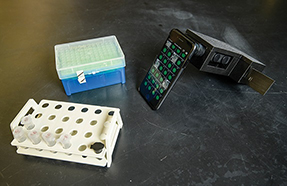Completed - Water and Environmental Technology (WET) Center
June 17, 2020
A little bit of norovirus — the highly infectious microbe that causes about 20 million cases of food poisoning in the U.S. each year — goes a long way. Just 10 particles of the virus can cause illness in humans. While norovirus is often associated with cruise ships, it can also spread quickly through a community via its water supply. Norovirus causes about 200,000 deaths globally each year.
Advances in rapid monitoring of human viruses in water are essential for protecting public health. Devices to detect norovirus in small quantities do already exist, but they typically involve a laboratory setting and require an array of microscopes, lasers, and spectrometers that can cost thousands of dollars and necessitate lengthy protocols.

With funding from the National Science Foundation’s Industry-University Cooperative Research Center (IUCRC) for Water and Environmental Technology (WET), a team of Univ. of Arizona researchers, led by Jeong-Yeol Yoon and Kelly A. Reynolds, has created a simple, portable, and inexpensive method for detecting extremely low levels of norovirus. This rapid, low-cost water-quality monitoring technology could be a transformational tool for reducing both local and global disease burdens.
To detect norovirus in the field, such as on cruise ships or in municipal water wells, the team decided to use simple materials: paper, in the form of microfluidic chips, and a smartphone. The nitrocellulose paper substrate is very inexpensive and easy to store, and it can be easily fabricated into a microfluidic chip. The fibrous structure of paper allows liquid to flow spontaneously without using the pumping systems usually required by other chips, such as silicon chips.
Scientists typically detect contaminants on microfluidic chips by measuring the scattering and reflection of light in a sample. However, paper’s porousness and opacity can cause background scattering that interferes with imaging — making it difficult to detect very small concentrations of a virus. Rather than measuring light intensity, the team developed a new way to detect norovirus by counting fluorescent beads.
The process starts with adding potentially contaminated water to one end of a paper microfluidic chip. The researchers used a pipette to deliver a known volume of sample onto the chip, but any type of dropper will also work. To the other end, a tester adds tiny, fluorescent polystyrene beads. Each bead is attached to an antibody against norovirus. If norovirus is present, several of the antibodies attach to each virus particle, creating a little clump of fluorescent beads.
Norovirus particles and their antibodies are too small to be imaged by a smartphone microscope. However, when you have two or more of these beads joined together, the clump of beads is large enough for a smartphone microscope to detect and photograph. A smartphone app the researchers created counts the number of illuminated pixels in the image to identify the number of aggregated beads and, subsequently, the number of norovirus particles in the sample.
“This user-friendly smartphone technology revolutionizes water-quality testing in the field. It delivers rapid, accurate results for norovirus and other microbial and chemical contaminants,” says Dan Quintanar, project manager, Tucson Water.
Each test costs less than $10. The most expensive component of the whole device — the smartphone microscope — is available commercially and costs less than $50. The end-user does not have to be a scientist or an engineer to run the microscope. The entire testing process is easy to complete because analysis is performed automatically by the smartphone app. Used paper strips can be safely disposed in any trash receptacle.
“The smartphone technology is a wonderful example of the National Science Foundation IUCRC Program enabling collaboration between the private sector and academia,” states Ian Pepper, Site Director, Univ. of Arizona, NSF WET Center.
In the future, the Univ. of Arizona team hopes to develop methods for detecting norovirus infections in patients even earlier and to expand their smartphone monitoring platform to detect other environmental hazards, such as potentially cancer-causing chemicals. They also plan to commercialize the device for periodic and continuous monitoring.
This technology was funded through the NSF Industry-University Cooperative Research Centers Program.
This article was prepared by NSF for AIChE and appeared in the February 2020 issue of Chemical Engineering Progress.
